
Microgreens: What Are They And How To Grow
Microgreens are the young seedlings of plants, which can be grown and harvested in less than three weeks. Delicious and packed with nutrients, they're well worth growing. Here's how to do it yourself, even if you don't have much space at your disposal.
Microgreens are tiny, edible plants that you can grow year-round on a windowsill, meaning that essentially anyone can grow their own food, even without any outdoor space. Sounds almost too good to be true, right? Well, fortunately, it’s not.
In this article, we explore what microgreens are, and how grow them at home.
What are microgreens?
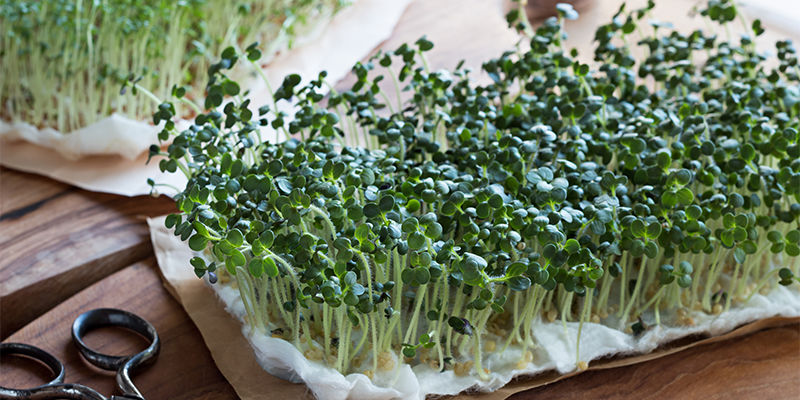
Microgreens are the seedlings of plants we would normally expect to eat when fully grown—usually salad greens. What makes a microgreen a microgreen, rather than just a salad leaf, is that it is harvested within around two weeks of sprouting. At this point, plants are still very small. So, why would you harvest them at this point?
There are a few good reasons to grow and harvest microgreens:
- Fast: harvest within two weeks of germination
- Grow all year round
- Grow on a windowsill
- Constant supply of nutrient-rich leaves
For those pressed for space, growing microgreens can be the best (and sometimes only) option for growing vegetables at home. If you don’t have space to plant rows of salad greens, then you can still grow your greens at home, even on the smallest, sunny windowsill.
What’s more, so long as you’re sowing new seeds on a weekly basis, you can harvest on a weekly basis too. Even if your harvests aren’t large enough to remove the need to buy veg from the shop, you will have a constant supply of your own produce too.
Microgreens might be small, but they are packed to the brim with nutrients, meaning they can be a very healthy addition to your kitchen.
Are microgreens the same as sprouts?
Not quite. Though similar, there are two main differences between sprouts and microgreens.
First, microgreens are grown to around two weeks old, whereas sprouts can be harvested within 1–5 days of sprouting. Plus, sprouts are grown only in water, whereas microgreens need to be grown in soil.
Second, sprouts are usually grown from beans and seeds that you wouldn’t normally grow into leafy plants—such as lentils of mung beans. Microgreens, on the other hand, tend to be plants such as spinach, rocket, and so on.
Are microgreens good for you?
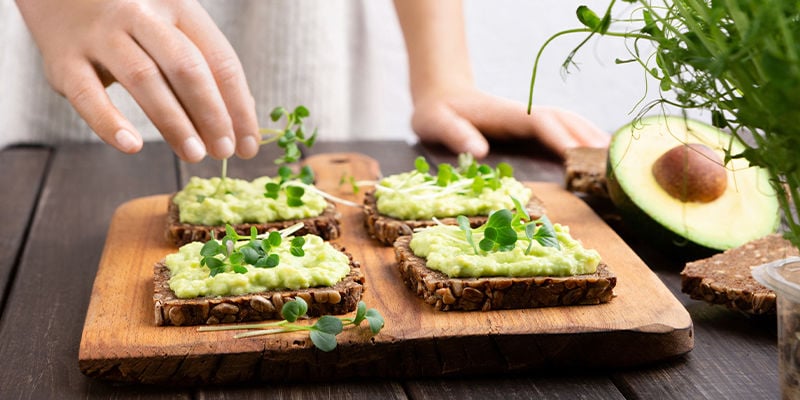
Yes, very. Microgreens are densely packed with nutrients, making them very healthy for their size. What’s more, they also have a very concentrated and rich flavour, which gives them a specific culinary use.
Gram for gram, they have a very high ratio of nutrients—particularly vitamins A and C. What’s more, some contain up to 40 times the amount of antioxidants compared to their mature versions. Therefore, if you’re growing and eating microgreens on a regular basis, then you’ll likely be consuming a healthy supply of nutrients, depending on which microgreens you choose to grow.
Certain microgreens (or microreds and purples), such as red cabbage, red mustard, purple mustard, and purple kohlrabi, actually contain a greater amount of nutrients compared to their mature versions, making them particularly desirable.
But there’s more to it than this. Growing plants is known to be good for people’s mental and physical health. And while growing microgreens isn’t particularly labour intensive, it still offers the mental catharsis of gardening. As such, if you spend the year tending to and harvesting microgreens, you can expect a little mental boost, as well as a nutritional one!
How to grow microgreens at home
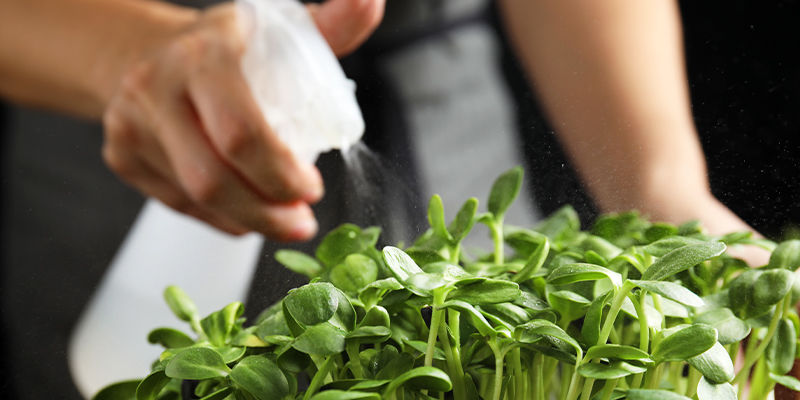
One of the reasons that microgreens are so good is that they are very easy to grow. In fact, aside from sprouts, they’re probably the easiest way to produce your own edible plants at home. If you’ve a little time and a windowsill that gets a fair amount of sun, then you have the means to grow microgreens.
Below, we’ll show you how to do it.
Which microgreens are best?
Almost any vegetable or herb can become a microgreen, and really, you can choose to grow anything you’re interested in trying, or plants you already know you love. However, some plants lend themselves more readily to becoming microgreens compared to others. Here are some popular choices:
- Rocket
- Radish
- Sunflower
- Beetroot
- Kale
- Broccoli
- Parsley
- Chives
- Dill
The main consideration when choosing which plant to grow is how leafy its seedlings are. You want to choose something that will produce a lot of leaves (relative to its size) within two weeks, otherwise you’ll find you don’t have much to eat!
Equipment
- Seeds of your choice
- Multi-purpose, peat-free compost
- Seed tray
- Watering can
Directions
Once you have the very few necessary pieces of equipment together, here’s what you need to do:
- Fill your seed tray with soil.
- Use your finger to make a very slight indent in the soil.
- Sow seeds evenly but fairly close together (it’s not as though the roots need much space!).
- Water with a fine mist.
- Place on a sunny windowsill.
- Water them regularly, but don’t drench them—just keep them moist.
- Continue for one to two weeks.
- Harvest!
Using guttering
Instead of using a seed tray, you can also grow microgreens in old guttering. In fact, as you won’t be growing one seed per compartment in the seed tray anyway, using guttering can be a better option.
To use guttering, first cut it to the desired length. Then, use duct tape to close up the two ends so that the soil doesn’t fall out. Then, fill with soil. Once it’s finished, just follow the method above to grow microgreens in guttering!
You might also want to create a little stand so the guttering stands up straight, as the bottom is rounded. You can do this simply by placing a line of stones in front and behind it so it doesn’t rock back and forth. Otherwise, you can find another way to do it.
How to harvest microgreens
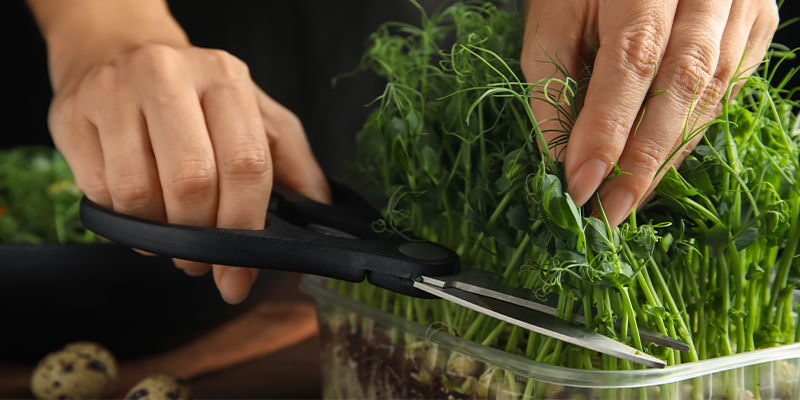
You can harvest microgreens after one or two weeks, depending on the plant, the time of year, and your desired size. Let them grow for longer than this, and they will become “baby greens”.
Once you think they’re ready for harvest, you can either pull them up, roots and all, or cut them off at the base using a pair of scissors. Both methods work well, and it really comes down to your preference.
Note that some microgreens are harvested before their first true leaves form, or right at the moment that they form. Examples include the likes of broccoli, turnips, radishes, and others. If you wait for more true leaves to form, the greens may start to get a little woody. Other microgreens, such as many herbs, are harvested once the second true leaf forms. Look up the information on your desired microgreen varieties to know exactly when to harvest.
Can microgreens grow to full size?
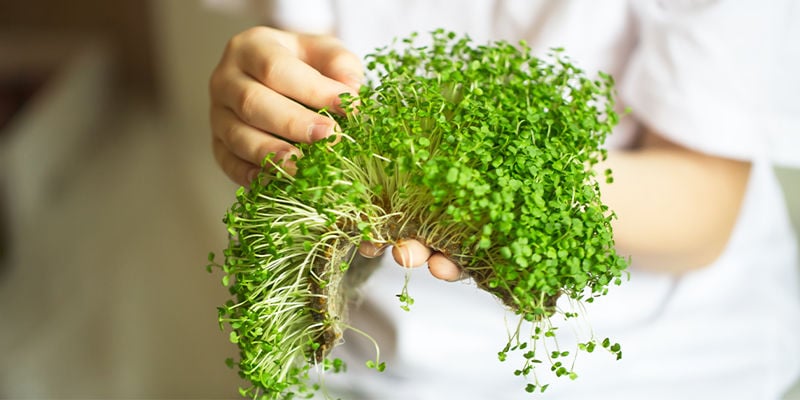
Yes, if you transplant them. Microgreens are just normal plants, so they will happily grow to full size in the right conditions. That being said, as they are planted very close together in small containers, they won’t be able to reach full size unless you move them to a roomier home.
If you leave them as you plant them, then they will grow to a certain size and eventually begin to die off.
Will microgreens regrow?
The vast majority of microgreens will not regrow after you harvest them. Even if you just cut off the vegetation, rather than taking up the roots, most will not be able to come back from having all of their growth cut away.
But there are a couple of exceptions to this.
Peas can be regrown, as, by the time you harvest them, they will have multiple sets of leaves, meaning you can leave one set after harvest. From this one set, it can grow more and be harvested again.
Wheatgrass can also come back, even after being cut back.
That said, most other plants can’t be regrown. And if you do choose to regrow the above-mentioned plants, then be aware that subsequent yields and quality tend to suffer as a result of being harvested and regrown. Plus, if you harvest them by pulling them up from the roots, they will not regrow!
Microgreens: seedlings packed with benefits
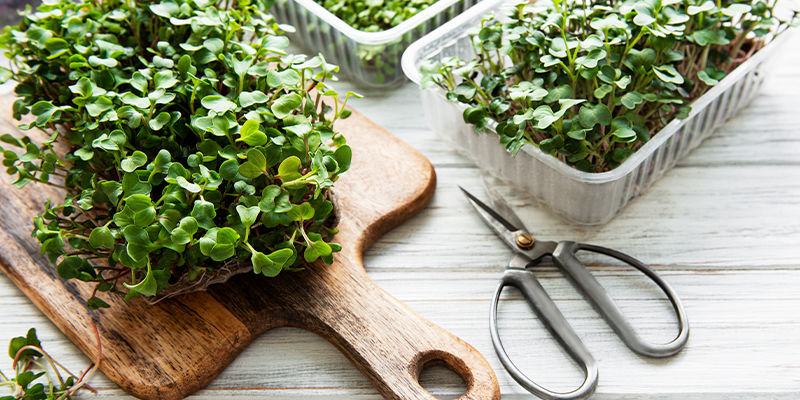
Microgreens might not allow you to be completely self-sufficient when it comes to your veg, but they do offer you an opportunity to grow greens at home, and they are delicious and incredibly healthy. Taking germination and growing time into account, even the most impatient growers should be able to deal with this turnaround.
Alongside nutritional benefits, microgreens also offer the cathartic mental benefits of tending to a garden, even if it is a very small one. For those living in apartments, who can only grow on windowsills, growing microgreens offers a unique opportunity. What’s more, you can grow microgreens all year round!
-
 4 min
August 14, 2023
How To Diagnose & Treat Cannabis Nutrient Lockout
Did you know that a common cause of nutrient deficiencies in cannabis is nutrient lockout? Keep reading to learn more about nutrient lockout, why it occurs, and how to best treat it to ensure a...
4 min
August 14, 2023
How To Diagnose & Treat Cannabis Nutrient Lockout
Did you know that a common cause of nutrient deficiencies in cannabis is nutrient lockout? Keep reading to learn more about nutrient lockout, why it occurs, and how to best treat it to ensure a...
-
 4 min
May 19, 2023
Discover 10 Unique-Looking Vegetables
Do you want to sow some strange and novel fruits and vegetables in your garden this spring? Well, look no further—we’ve got you covered with this top 10 list of odd-looking plants to add some...
4 min
May 19, 2023
Discover 10 Unique-Looking Vegetables
Do you want to sow some strange and novel fruits and vegetables in your garden this spring? Well, look no further—we’ve got you covered with this top 10 list of odd-looking plants to add some...
-
 5 min
March 16, 2023
Top 10 Easiest Vegetables To Grow
Have you ever considered growing vegetables from home, but thought that your level of expertise or environment was insufficient for the job? Well, here at Zamnesia, we don't believe in such...
5 min
March 16, 2023
Top 10 Easiest Vegetables To Grow
Have you ever considered growing vegetables from home, but thought that your level of expertise or environment was insufficient for the job? Well, here at Zamnesia, we don't believe in such...
-
 3 min
January 24, 2021
Comparing Liquid Nutrients Vs Granular Nutrients
There are plenty of anecdotes about what works best for cannabis plants, and everyone you ask will have their own techniques and tricks. But there is one common connection that links them, and...
3 min
January 24, 2021
Comparing Liquid Nutrients Vs Granular Nutrients
There are plenty of anecdotes about what works best for cannabis plants, and everyone you ask will have their own techniques and tricks. But there is one common connection that links them, and...











 United States
United States








